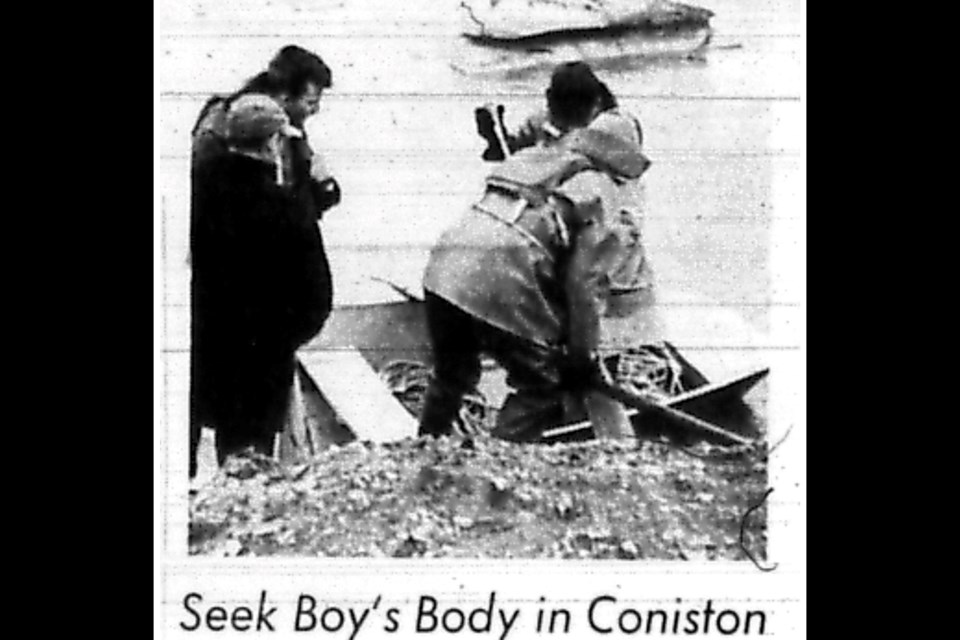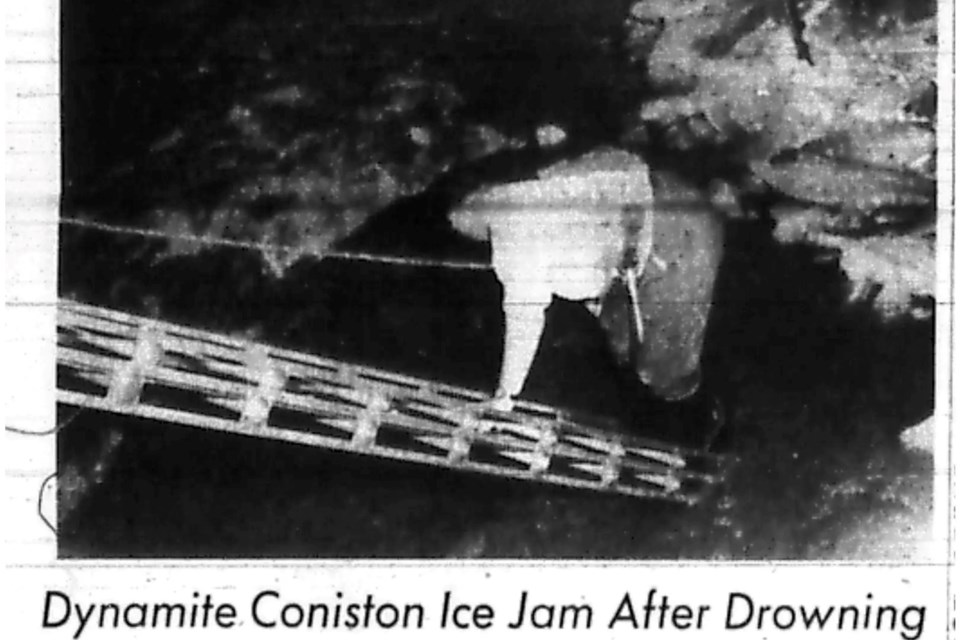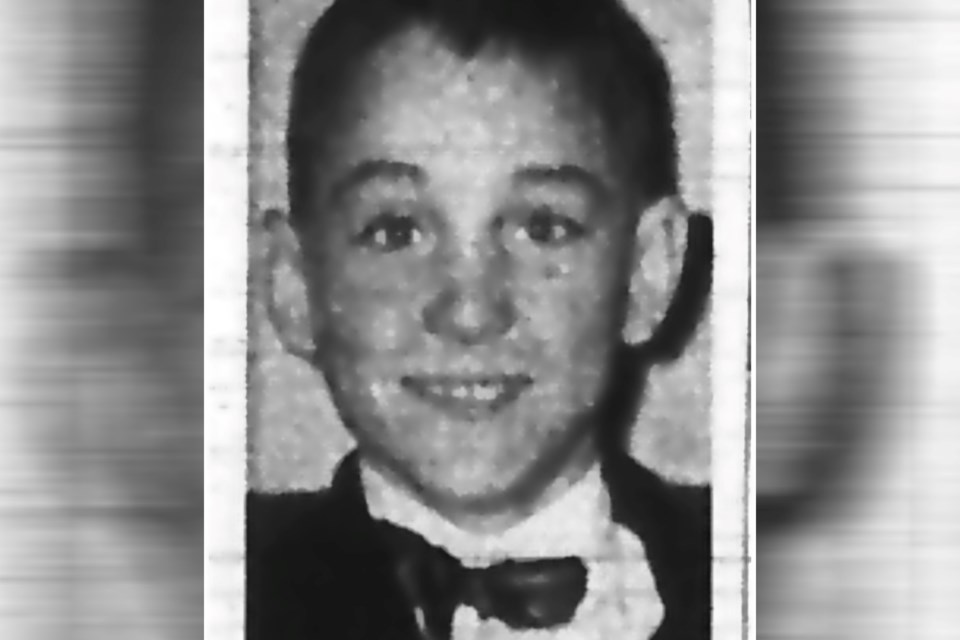On Sunday, April 12, 1964, the weather was cloudy and hovering around 10 degrees by midday. The last traces of old man winter’s gloom were nearly gone, though there was still a fair amount of snow that lingered in spots (the average remaining ground snow recorded that day was 5 cm).
Unfortunately, for four young Coniston boys, enjoying the waning hours of their weekend away from school, the day was about to take a deadly turn that would also thrust two local men into heroic action.
Near supper time that day, two sets of brothers, Sylvio (age 9) and Gilles Leblanc (age 7), alongside Raymond (age 7) and Paul Boulay (age 5), were playing on the ice of the Coniston Creek, chipping sections off with sticks. Suddenly, things took a turn when the water level began rising rapidly. An ice jam had broken apart upstream of the boys’ location. This sudden increase in water plunged three of them — Sylvio, Gilles and Paul — into the swollen creek. The elder Boulay, Raymond, just missed being tossed into the creek along with the others.
An eye-witness at the scene, Bill Coppo, said at the time that he observed the boys fall into the creek as “the water appeared to rise suddenly.” Sylvio Leblanc, Coppo said, was swept down the creek. According to Coppo, it appeared that Sylvio had attempted to swim to shore while grabbing at ice floes. However, he became visibly tired and disappeared from sight.
Two men who witnessed this turn of events hurried to the scene, arriving not long after the incident had occurred and immediately plunged into the waters of the creek that divides old and new Coniston in an attempt to rescue the boys.
When the job was done, they were said to have left the scene as quickly as they had arrived. When a reporter appeared later on, not a single one of at least 10 people queried at the scene could recall who these heroic men were. They were later identified as Robert Henderson, who was an employee of the Town of Coniston at the time, and his brother-in-law, Roger Menard, a smelter worker with INCO.
Henderson said at the time that he was standing on the bridge with Menard, when they witnessed Sylvio fall into the water. They then ran the 500 feet along the shore to try to save the boys. At this point, Henderson said that he dove into the rampaging creek in a vain attempt to save Sylvio Leblanc. Unfortunately, his water-soaked clothes dragged him almost 12 feet and to the bottom of the creek.

"I jumped in fully clothed to grab the boy but I had rubber boots on and they dragged me under," said Henderson.
By the time he would kick his boots off, Sylvio had gone by "fighting desperately to grab a piece of ice." As Henderson continued, Sylvio was travelling “almost 10 miles an hour like a ping pong ball. He went down a couple of times and never came up."
Meanwhile, Menard waded into the chest deep cold waters and lifted the other boys, one at a time, out of the water and carried them over his head to the safety of the shore. While awaiting his rescue along with young Paul Boulay, Gilles Leblanc recalls observing a gathering crowd nearby who were attracted by the noise. Even with everything going on, “(I) could see many people gathered on the old Coniston Road bridge,” said Gilles.
At the Coniston Firehall, a warning siren was sounding to inform the town that an incident had occurred. This also signalled to local firefighters, as well as any capable volunteers, to gather at the firehall for further instructions.
As the rescued boys were not injured in any way, they were removed from the scene and returned home as soon as possible. Gilles Leblanc remembers “walking home after having been rescued and meeting my Dad (Alphonse Leblanc) on the way home. I will never forget the look on his face. He quickly told me to go home (while) he kept going” to get to the scene of the accident.
“On my way home,” Gilles continues, “I was still thinking that my brother was coming home since I (had been) pulled out.”
Unfortunately, Sylvio could not be located and after many hours at the site, Leblanc returned home that evening to tell his wife of the situation as it stood at that time. Gilles remembers that his mother took the news hard, but that the community immediately rallied around the family to offer both comfort and assistance.
“As they were discussing things, my mom almost collapsed,” Gilles said. “(But) in no time at all, our house was full of neighbours, family and friends to provide support and comfort … l’m sure all this support was helpful.”
Attempts to locate Sylvio continued into the night under the direction of Coniston Fire Chief Art Gobbo. Coniston Mayor Michael Solski was among the volunteer searchers who used flood lamps all night long searching the area for any signs of Sylvio. It was feared the boy was either trapped under the ice dam, which was measured at 26-inches thick at that location, or had been swept further downstream into the Wahnapitae River.
The next day, the search effort continued. Two boats manned by local firefighters working with grapnels and pike poles probed the swollen creek waters, which had now subsided considerably. Rescue crew members (made up of firefighters, municipal staff and community volunteers) also resorted to dynamiting another ice jam that had formed in and around the Government Road bridge, which crosses the creek south of the location where the boys had been rescued.
During this time, the town engineer, Peter Vanderhenne, could be found working from a firefighter’s ladder setting up dynamite charges to break up the ice jam. By the end of the day, with the assistance of levers, the ice was pried loose and the search could continue.
Terry Deforge, only four years old at the time, recalls standing on the bridge watching them drag the creek in a vain attempt to find Sylvio. As he puts it, “I remember the ‘busy’ atmosphere as being very quiet, you could hear your heartbeat regardless of all the people gathered. I also remember the water looking so cold and dark.”
Even at that young age, Deforge said he remembers his thoughts went to the Leblanc family. “I couldn’t imagine what his family was going through, just waiting,” he remembers today.
Mr. Leblanc was known to be a religious man and was anguished that his first born could be taken away from him. He visited his church to seek counsel from his parish priest, Father O. Campeau. Mr. Leblanc was particularly upset by talk of abandoning the search for his son to wait for more favourable conditions.
At this point, it had already been five days since the accident.
As Gilles Leblanc tells it, “Father Campeau gave (his father) blessed bread to throw in the creek.” The bread floated away down the creek and attracted seagulls that proceeded to consume it. The location along the creek where this blessed bread ended its journey turned out to be the spot where Sylvio was found.
On Friday, April 17, 1964, just before noon and five days after he disappeared into the water, Sylvio was discovered some 100 feet south of the Government Road bridge.
Gilles “remember(s) my parents trying to explain to me what happened, not sure if I would understand the meaning of death … both my parents were very distraught.” Unfortunately, denial is a strong feeling across all of humanity. “I remember after being told by my parents that he was gone, (but) a part of me still thought he was coming home.” In the end, “a few days later,” he said, “I knew he was gone.”

In the immediate aftermath of this incident, officials issued a warning to youngsters, telling them to stay away from creeks and lakes in the Sudbury area (on the same weekend another youngster, Rene Gauthier, 11, was pulled from the rushing waters of Nolin Creek by a city firefighter).
Sudbury Fire Chief Bob Scott noted that the banks of creeks are muddy and slippery at this time of year. "A child playing near a creek can easily slide into the water. Once in, he has little chance in the fast current and cold water." Scott said.
"Parents should warn their children of the dangers, and the general public should call us if they see youngsters playing near or on city creeks," City of Sudbury Deputy Police Chief Bert Guillet said at the time.
In those days, tradition called for a funeral wake lasting five days. Gilles remembers spending most of the following week preparing for the wake and at the funeral home with his family (which included younger siblings, Carole and Michel).
As Gilles remembers, “our parents continued to explain what had happened to Sylvio to both myself and my younger sister Carole … this took a very heavy emotional toll on both my parents, especially my mom.”
However, the community continued to provide a huge emotional support to the Leblanc family. The funeral mass was held at Paroisse Notre Dame de la Merci in Coniston. It was full to the brim with mourning community members. As well, most of the town’s school children were also in attendance to support the family of their schoolmate.
In the aftermath of this incident, Coniston Mayor Mike Solski publicly thanked all of the volunteers who assisted in the search day and night throughout the previous week. He also announced that the town would be applying for provincial aid to divert, slow down or dam the waters of the Coniston creek. "Because of an uncontrollable rush of water from the Neelon-Garson area, this creek can become a lake in a very short time," said the mayor.
In his announcement, he cited the accident as an example of what can go wrong.
"A few hours before the drowning," Solski stated at the time, "people who went past the creek said the water was normal. Then later, it let loose somewhere above the town, rushed down toward Coniston, and lifted all the ice in our area."
The mayor blamed water that collects in the hills north of the town. He said that since there is no vegetation to hold the water back, it runs into the creek and onward to Coniston.
Over the years, many Coniston children (and their children as well, including your author) were warned away from the creek with memories of this accident remaining fresh in their minds.
“As a matter of fact,” former Conistonian Terry Deforge writes, “every time since then when I was near that creek, I would think about Sylvio and that fateful day, and it made me afraid to ever go down to the water in that creek. My parents never had to worry about me, it scared me!”
Today, exactly 60 years after the accident, we take the time to mourn the loss of a life that was just beginning. We also honour the actions of the two men — Roger Menard and to the late Robert (Bob) Henderson — who thought of nothing but to jump into action and help at that time of need. Thank you to the citizens of the Town of Coniston who rallied around one of their own families who were hurting and lifted them up with their support. And, finally, to Pierre and Carole Leblanc, who shared their memories about the loss of their eldest brother for this article, .thank you so much.
A day like any other
Life changes
In a flash, rather
By choice of angels.
Youth,
Full of beauty
Dealt a hand of uncouth
Cruelty
What Remains, ill at ease
Tho, As time
Onward carries
Mourning lost lifetime.
Rest in Peace Sylvio.
(By Jason Marcon)
Jason Marcon is a writer and history enthusiast in Greater Sudbury. He runs the Coniston Historical Group and the Sudbury Then and Now Facebook page. Then & Now is made possible by our Community Leaders Program.
